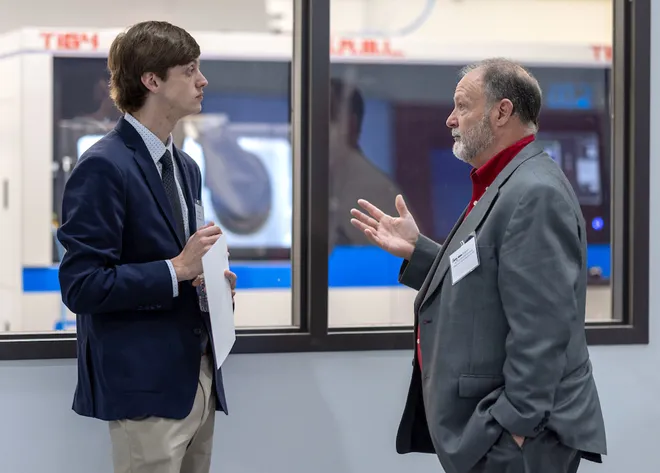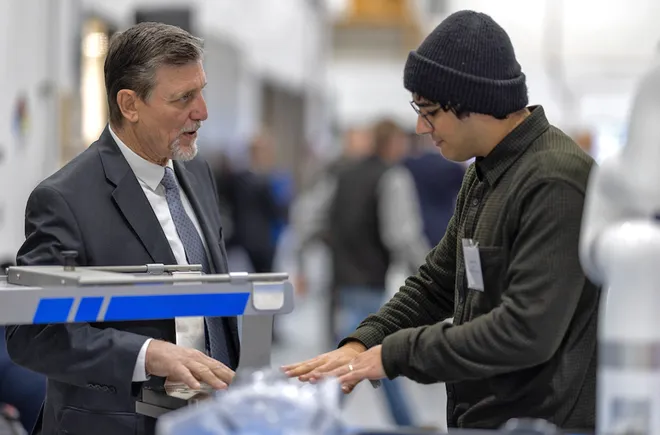The University of Oklahoma has opened its new Sooner Advanced Manufacturing Lab, which uses metal 3D printers and other technology that will help in the production of aircraft parts and in conducting research to support military and industrial aerospace partners, particularly in Oklahoma.
Housed in a nondescript building next to a convenience store in north Norman, the 5,000-square-foot lab — formerly home to a pipe organ institute — held its official opening ceremony on Tuesday. The lab provides a collaborative space for work done by faculty and students in OU’s Gallogly College of Engineering and the Oklahoma Aerospace Defense Innovation Institute (OADII).
The lab serves as an OU hub for “additive manufacturing,” a computer-controlled process that creates three-dimensional objects by depositing materials, layer by layer. All sorts of materials can be used in additive manufacturing, but the 3D printers at the OU lab will focus on creating objects out of titanium and stainless steel.
“It’s a big step forward in capability,” said John Auld, a retired Air Force officer who’s the lab’s site director and the innovation institute’s project manager. “It’s integrating multiple departments from within OU. You have computer scientists, you’ve got industrial systems engineers, you have aerospace and mechanical engineers, electrical engineers — and that’s not the whole list. We’ll continue to see what grows as we move forward and the research opportunities out there as more folks get involved.”

How the Sooner Advanced Manufacturing Lab was imagined and built
The idea for such a facility began about five years ago and received support from throughout the university, said Yingtao Liu, the chairman of the graduate programs in OU’s School of Aerospace and Mechanical Engineering.
“The whole university recognized how important additive manufacturing can be and the broader impacts it could bring to this entire community,” he said. “We could not make this happen by ourselves.”
The centerpiece of the lab is a pair of GE M2 Series 5 Metal 3D printers, one of which uses titanium and another that uses stainless steel to print items. The printers, which cost about $1.3 million each, sit in a climate-controlled room within the lab and are equipped with hundreds of sensors that wouldn’t be practical to use in a production environment, said Chris Billings, a research assistant engineering professor. Those sensors allow researchers to precisely determine the necessary specifications of an object and to meet the critical requirements of the highly regulated military and aerospace industry.

The lab also maintains cross-cutting equipment for testing parts, digital twin, Computer Aided Design modeling, precision cutting and polishing, and more.
“We can mirror production, but our main focus is research,” Billings said. “We have hundreds of sensors throughout, to find the best way to optimize production, whether that be safety, output or final part tolerance. We can figure out all of the issues that happen in production in additive manufacturing and then go to our partners, like the Air Force, and say, ‘We’ve done all this testing in a lab that’s very similar to yours, and here’s what you can take over to your lab and make it work.’”

That saves the lab’s partners both time and money, Auld said. For example, OU researchers can help in reverse engineering and creating parts for old military aircraft for which original drawings or design specifications might no longer be available. That will allow those planes to stay in service longer, he said.
While much of the lab’s current work will focus military applications — one of its primary partners is nearby Tinker Air Force Base — the technology used in the lab could be used in other research areas, such as in the energy or biomedical industries, said Zahed Siddique, the assistant dean for research for OU’s engineering college.
“This is just the start,” Siddique said. “We started with these two specific ones because of what our partners wanted to do. The next phase is going to vendors and other manufacturers and looking at a broader application.”

Subscribe to AM Chronicle Newsletter to stay connected: https://bit.ly/3fBZ1mP
Follow us on LinkedIn: https://bit.ly/3IjhrFq
Visit for more interesting content on additive manufacturing: https://amchronicle.com


